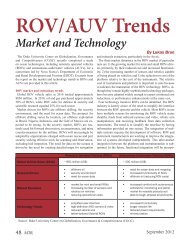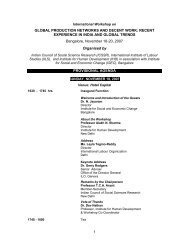Paper - Center on Globalization, Governance & Competitiveness
Paper - Center on Globalization, Governance & Competitiveness
Paper - Center on Globalization, Governance & Competitiveness
You also want an ePaper? Increase the reach of your titles
YUMPU automatically turns print PDFs into web optimized ePapers that Google loves.
Draft<br />
furniture upholstery at a local community college. The interdependencies am<strong>on</strong>g firms<br />
in each of these places gave them certain advantages over more isolated firms. But are<br />
they all clusters?<br />
The “associative ec<strong>on</strong>omy” is the term that encompasses all forms of business-based<br />
interdependencies. But that term also includes many distinctive forms of associati<strong>on</strong>,<br />
e.g., clusters, clubs, and networks. Each represents a means for companies to acquire<br />
ec<strong>on</strong>omies of scale that are external to their firm. But they are quite dissimilar<br />
ec<strong>on</strong>omic structures and resp<strong>on</strong>d to very different public sector approaches. A decade<br />
ago, networks were the strategy of choice for increasing industrial competitiveness in<br />
most of the world, with major programs promoted, supported, and studied by United<br />
Nati<strong>on</strong>s Industrial Development Organizati<strong>on</strong>, the World Bank, USAID, the European<br />
Uni<strong>on</strong>, and Organizati<strong>on</strong> for Ec<strong>on</strong>omic Cooperati<strong>on</strong> and Development. The transiti<strong>on</strong><br />
from policies to build networks to policies to build clusters—and to a large extent back to<br />
networks—is a story of evolving ec<strong>on</strong>omic development practices and the benefits of<br />
shared experience.<br />
Firms with like or complementary needs organized themselves into networks and<br />
clustered l<strong>on</strong>g before these relati<strong>on</strong>ships were understood by public policy to be<br />
“competitive advantages.” Although recent researchers have highlighted Europe,<br />
it was not a foreign c<strong>on</strong>cept in the U.S. Despite the comm<strong>on</strong>ly held image of the<br />
rugged individualistic industrialist, networking was comm<strong>on</strong> practice in the early<br />
decades of the twentieth century. Firms clustered in industrial cities such as<br />
Grand Rapids (furniture), Philadelphia (textiles), Providence (jewelry), and<br />
Cincinnati (machine tools). “Clusters of small companies in urban industrial<br />
districts offered diverse finished goods to households and enterprises, relying <strong>on</strong><br />
thick webs of c<strong>on</strong>tact and affiliati<strong>on</strong> to organize producti<strong>on</strong> and sales.” 4 Firms<br />
represented loose networks…with informal rules of entry, reciprocity, and<br />
propriety, that engaged a broadly shared set of technological challenges and<br />
comm<strong>on</strong> finance, marketing, and labor process dilemmas.” The growth of the<br />
vertically integrated corporati<strong>on</strong> never eliminated the small specialty<br />
manufacturers that c<strong>on</strong>tinued to rely <strong>on</strong> <strong>on</strong>e another to get externalities and solve<br />
their problems.<br />
Networks: The “flexible manufacturing network,” like the cluster, was rediscovered in<br />
western Europe—particularly in northern Italy—where inter-firm collaborati<strong>on</strong> was<br />
documented and explained by researchers such as Sebastiano Brusco and Charles<br />
Sabel and described by organizati<strong>on</strong>s that enabled it such as the Nati<strong>on</strong>al<br />
C<strong>on</strong>federati<strong>on</strong> of Artisans in Emilia Romagna and the Steinbeis Foundati<strong>on</strong> in Baden<br />
Wurttemburg. Spurred by numerous site visits organized with assistance from the<br />
German Marshall Fund of the United States, by the mid-1990s nati<strong>on</strong>s around the<br />
world, U.S. states, and private foundati<strong>on</strong>s were all supporting programs that<br />
encouraged inter-firm cooperati<strong>on</strong>. The c<strong>on</strong>cept was simple: companies would join<br />
together to achieve ec<strong>on</strong>omic goals unattainable by a company <strong>on</strong> its own. They would<br />
network to produce more complex goods, extend their market outreach, acquire costly<br />
resources or services, or simply reduce costs.<br />
3<br />
RTS, Inc.
















